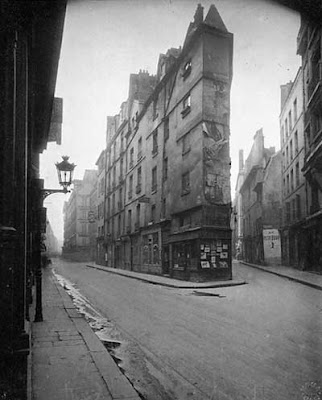 I wrote recently that Borges's fiction is often structured around scenes whose drama derives from the structural logic of the cinema. And some time ago, in a reading of a number of stories from Historia universal de la infamia and Ficciones I suggested that their guiding logic was often an accumulation of almost imperceptible (and seemingly random) deviations from the norm.
I wrote recently that Borges's fiction is often structured around scenes whose drama derives from the structural logic of the cinema. And some time ago, in a reading of a number of stories from Historia universal de la infamia and Ficciones I suggested that their guiding logic was often an accumulation of almost imperceptible (and seemingly random) deviations from the norm.Putting these two observations together, I think we see how there are various possible relations between what we can call the logic of minimal deviation and the structure of the cinematic scene. Sometimes one leads to the other, sometimes the two complement each other, sometimes they are in tension, and so on. At times Borges seems to be asking how much deviation (or how many minimal deviations) are required to provoke a scene. At other times he wonders how many deviations any particular scene can handle. And there are still other cases in which he proposes that it is only by making a scene that the logic of gradual accumulation can be brought to a halt.
Take "La muerte y la brújula," for instance. Here the detective, Lönnrot, carefully and slowly follows the "periodic series of bloody deeds" (147; 147), each of which is but a slight variation on its predecessor, until he arrives at the climactic scene that gives (renewed) sense to the series itself. Or "Tlön, Uqbar, Orbis Tertius," which begins with a paradigmatically cinematic scene: a dinner with Borges's friend Bioy Casares, a glance at a mirror that provokes a citation and then the fruitless search for its origin. This then opens up a concatenation of curious circumstances, each one of which could easily be overlooked: an additional encyclopedia article, a package from Brazil, a compass packed in a crate of table service, a dead man who owns an unusually heavy metal cone. Together, however, they constitute a new world.
Or, for another type of relationship between the scene and the imperceptible deviation, see "El milagro secreto" ("The Secret Miracle"). This is the story of Jaromir Hladík, a Czech scholar who is captured by the Nazis in Prague in early 1939. He is soon tried and sentenced to death by firing squad. In the interval between the sentence and its execution, Hladík reflects upon his life's work and the fact that it is soon to be cut short. He asks God for a year in which he could complete his masterwork, a verse drama entitled The Enemies. It hardly seems that this wish is to be granted when the characteristic scene of the firing squad is assembled: a bare yard, soldiers hanging around waiting for the appointed hour, the offer of a final cigarette, a cloud in the sky, a heavy drop of rain. But then all of a sudden "the physical universe stopped" (172; 161). And Hladík is indeed given his year, in the course of what for everyone else is but an instant, in which he can work out in his head the completion of his play. When finally he finishes his task, chooses the last epithet, "the drop of water rolled down his cheek. He began a maddened cry, he shook his head, and the fourfold volley felled him" (174; 162). Here, then, the scene contains the imperceptible deviation that in turn allows for the concatenation of revisions in which the book is completed before we then return back to the scene for its dramatic conclusion.
Either way, however, I think that what's at issue for Borges is the connection between habit or the routine, with its many repetitions none of which is quite like the last, and drama or the exceptional. How does the dramatic scene, with all its novelty, arise from routine repetition? Why is it that we are suddenly confronted with a decision or choice that only in retrospect we can understand has been a long time brewing in all the vagaries of chance? Or how, by contrast, does the scene itself become routinized or habitual? For after all, in Hladík's case, the firing squad scene was absolutely unexceptional from the point of view of those at the other end of the gun. Is then drama just habit viewed from some other perspective, whereby the otherwise imperceptible variation suddenly comes to take on unusual significance? And cannot even the most compelling of scenes, or the most vital of confrontations, be reframed such that the differences they invoke become strangely inconsequential?
So, for example, in both "Tema del traidor y del heróe" ("The Theme of the Traitor and the Hero") and "Pierre Menard, autor del Quijote" ("Pierre Menard, Author of the Quixote"), the most imperceptible of differences are suddenly given dramatic import. And we will see above all in two stories in El Aleph--"Los teólogos" ("The Theologians") and "Emma Zunz"--how distinctions that are quite literally matters of life and death can, with a sudden twist of perspective, suddenly come to matter not in the slightest.
But in Ficciones the emphasis is on how habit and its banal repetitions can, like the mirror against which Bioy Casares warns us in "Tlön," produce monsters.



